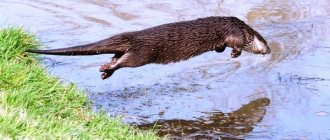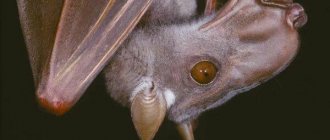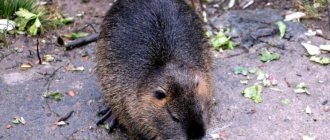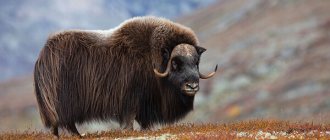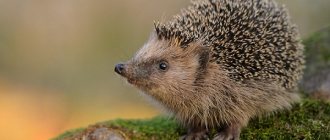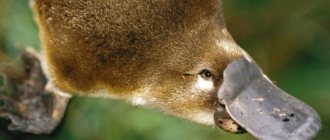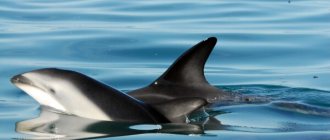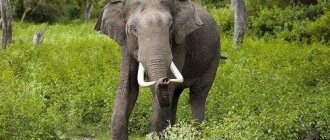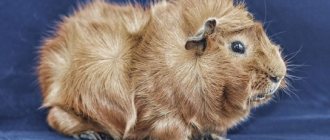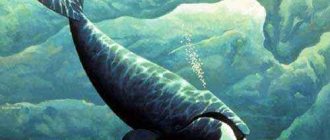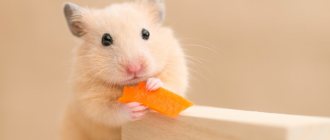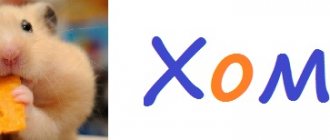Lifestyle
Inside it is tightly interconnected with water. The fur-bearing animal dives well and stays in the water. Does not like hot weather, surviving in dark places. At the same time, nutria also does not like the cold, but can tolerate frost up to 35 degrees. The water beaver does not store food for the winter, does not build a shelter, and is not adapted to survive in freezing bodies of water.
Swamp animals live in branched burrows and accumulate in families consisting of 3-12 individuals. Each family has a main male, 2 or 3 females and their children. Young nutria live independently. At the same time, the rodent can build a nest intended for rest and breeding.
Since the fur-bearing animal is prone to a different way of life, activity manifests itself at night. Nutria has good hearing, but cannot boast of charm and eyesight. With a strong jumping run, the animal quickly gets tired.
Nutria fur
Nutria - river inhabitant
Nutria, or coipu, or ragondin (French), or swamp beaver (lat. Myocastor coypus) is a mammal of the rodent order, the only species of the nutria family (Myocastoridae). The scientific name of the species, coypus, comes from the Araucanian language. The popular name for nutria is beaver or water rat, due to its similarity with beaver and rat.
Wild nutria is common in South and North America and Europe. Originally from South America, nutria was brought to Russia in 1929 from Argentina. The most successful acclimatization of nutria took place in Transcaucasia, Azerbaijan, Georgia, Armenia, and Tajikistan.
Nutria lives on the banks of ice-free small, slow-flowing rivers, lakes and swamps. These are mainly freshwater, but sometimes brackish bodies of water, where nutria build burrows, houses, shelter from the heat and find food. In nature, nutria leads an amphibious lifestyle, swims and dives well, and is active at dusk and at night.
An adult nutria weighs 5-7 kg, especially large individuals reach 12 kg. Nutria has a dense build, body length 45-60 cm, a round tail 25-35 cm long, covered with thick hair and dark gray scales, and membranes between the toes of the hind paws.
The nutria's head is large, flattened, with a rounded muzzle, turning into a powerful short neck. The small eyes are located so as to provide the swimming nutria with a good view. On the muzzle there are thick hairs - vibrissae, which are organs of touch. The teeth are orange, large and sharp. The ears are small, with fluffy hairs growing inside, trapping air and preventing water from penetrating inside. The large nostrils also close against the water due to the muscles that contract when diving.
The hair of nutria consists of hard covering hairs and short, soft underfur. The bulk, 93–98%, of the wool is downy hair, crimped along the entire length. The density of nutria fur reaches 15-16 thousand fine hairs per square meter. cm skins. The undercoat on the belly and sides is thicker than on the back, which helps to better retain heat in the lower part of the body. The long, rough awn protects the delicate down from water and mechanical damage, so nutria’s fur is waterproof and shiny.
The natural color of nutria fur is brownish-brown; on the sides the fur is lighter, with a yellow tint. The undercoat is brownish in color. Based on color, nutria are divided into 5 groups: brown, white, beige, golden and black. In total, about 30 colors are known.
Breeding colored nutria
In the first half of the twentieth century, prices for nutria fur were so high that populations of animals living in natural conditions were almost completely exterminated. True, after a few decades in some places they managed to recover again.
In the early 20s of the 20th century, nutria began to be bred in captivity in Argentina, from where later, in the 30s, they were brought to the USA, Europe and Asia. Thus, in the period from 1930 to 1940 in Germany there were about 1000 nutria farms, which produced about 100 thousand skins per year. Until the early 1950s, nutria farming in Russia existed only in the southern regions of the country, where the unfavorable cold period of the year lasts for a short time. However, later nutria began to be successfully bred indoors, and fur farms began to be built in the central and even northern regions of Russia.
The most common and easy to breed are standard nutria, which have fur from light brown to dark brown, with a steel or reddish sheen. Compared to other fur-bearing species, nutria are not picky about their living conditions and are resistant to various diseases. They live and breed well in captivity. In addition, these animals are very funny and pleasant to watch. Breeding in the natural environment is practiced only in the southern regions of Russia, where the climate is mild and warm, and only minor frosts are observed in winter.
In recent years, cell breeding of standard and colored nutria has become popular in Russia and abroad. Based on hair color, 10 mutational and 7 combined types of nutria are known, which were obtained as a result of a long process of breeding, variability and heredity of the animal body. The color forms of the hairline made it possible to create new breed groups, very different from the standard dark brown nutria.
There are also smoky, snow, pearl, straw, cream, white northern and albino, brown exotic nutria. All color types of nutria reproduce well, bringing viable offspring, which, subject to the recommended feeding and maintenance methods, grow and develop well and produce high-quality skins. Colored skins are valued higher than standard colored skins.
Types of nutria mutation flowers:
— Standard nutria are the most common.
- White Azerbaijani - with white down and awns.
- White Italian - with white fur of a cream shade.
- Silver - dark gray in color, with a silver-gray spine and a bluish-slaty underfur.
- Pearlescent - with light brown, almost beige hair, with white tips and creamy blue smoky down.
- Beige - with brown smoky and dark beige guard hair and dark down.
- Golden - with a golden spine and light yellow or yellow pink-golden down.
— Pastel - with a color from light to dark brown.
- Black - with a dark awn and dark gray down, sometimes with a brown highlight at the ends of the hair.
— Lemon nutria – with light yellow spine and down.
White Azerbaijani nutria was bred in Azerbaijan. All guard and down hairs of white Azerbaijani nutrias have a pure white fur color. The exceptions are the areas around the eyes, at the base of the tail and under the ears, where there may be colored guard hairs or, very rarely, guard and down hairs, with a total area of no more than 10%. These nutrias are a breed group.
White Italian nutria, originally from Italy, was brought to Russia in 1958. It has a light cream colored downy fur. Sometimes the color of the fur can turn into a light gray-brown. The fur of such nutria should have guard hairs of a pure white color, but some animals may have a gray-brown tint on the guard hairs, which makes the fur appear dirty. Such nutria are discarded.
Golden nutrias were brought to Russia from abroad and have bright yellow-golden fur. The guard hairs are golden or light golden in color, and the down hair is yellow or light yellow with a golden tint. The most valuable are the representatives of nutria, which have the least pronounced difference in the color of the fur on the back and stomach.
Black nutria were introduced to Russia in 1966. The guard hairs are black, the underfur is dark gray. Moreover, the hair of black nutria is pigmented along the entire length of the hair; zonally colored hairs are found only behind the ears. When crossed with representatives of their own breed in the first generation, black offspring are obtained. In subsequent generations, cubs of a standard color with dark brown fur may appear. When black nutrias are crossed with standard nutrias, the first generation produces babies with black or dark brown coloring, but without zonally colored hair on the back or sides. However, with age, the color of the offspring, as a rule, changes and acquires a zonal character, clearly expressed in the head and sides. Such nutria are called black zonal.
Beautiful and warm nutria fur
Nutria fur is beautiful, warm and light, and is not afraid of moisture, which is especially important for the domestic climate, when there is frost in the evening and morning, and rain during the day. Nutria fur consists of thick, soft, silky, short, crimped down and a rare coarse, hard, long awn. The guard fur of nutria is shiny and much longer than the underfur. Hair thickness can be changed by stretching.
Nutria fur is attractive with its various original colors and durability. The natural color of wild nutria fur is not very attractive, so it can be dyed in more saturated colors. Colored nutria fur is more valuable and more difficult to obtain, and therefore it is often used for sewing designer items or youth clothing.
Nutria skins can be shorn or unshorn, plucked or unplucked, dyed or undyed. Nutria fur coats are made both from ordinary skins and using original fur processing. Nutria fur, if cut, dyed and polished in a special way, may well be visually similar to mink fur. Therefore, it is often used to imitate mink. Plucked nutria fur with the guard hairs removed is similar to the fur of a shorn beaver. Nutria, which is cheaper in price, is often also tried to be sold under the guise of beaver fur, but nutria fur, unlike beaver fur, does not have fluff, which warms. In any case, a specialist will always determine the “similarity” of the fur from its true origin.
Nutria fur should not be old - this is the most important condition for a high-quality fur coat. The age of the animal is not important, but the quality of the fur is important, because due to improper storage or non-compliance with the skin processing technology, even the “youngest” fur can become old. Old fur has a greasy feel to the touch and is shiny on the fingers; stale, stale fur has a certain “old” aroma.
Nutria fur is more wear-resistant than muskrat and marten fur, and its weight is less than rabbit fur, so products made from it are light, beautiful and durable. In terms of wearability, in its natural form, nutria fur is close to mink or fox, and rabbit fur is 10 times superior. Fur coats, coats, collars, and hats are made from nutria fur.
The cost of a charming nutria fur coat has a wide price range. Everyone can choose something to suit their taste and budget. Either budget models, accessible to any fashionista, or expensive exclusive models made of multi-colored “plucked” nutria fur.
Thanks to the special structure of the fur, a nutria fur coat is perfect for the winter of central Russia and can withstand wet snow and rain. Upon returning home, you just need to vigorously shake the fur coat several times, hang it on hangers to dry, and then comb the fur with a hair brush. It is quite easy to clean a nutria fur coat from street dirt: you just need to dry the product and comb it with a brush with medium-hard bristles.
There is a common misconception that the quality of Argentine wild nutria skins is better than our captive bred ones. This is not at all true; nutria fur is of better quality, the animals of which live in the best wild or caged conditions. Animal nutrition also plays an important role. Therefore, with good care and access to a pool, animals grow larger than their wild counterparts, and the quality of their skins is better, since they are not damaged by fights and parasites. The skin of cellular nutria is larger; adult wild nutria weighs 5-7 kg, and domestic nutria weighs 9-10, and sometimes reaches 12 kg. The body length of nutria is 45-60 cm, males are larger than females, and their fur is thicker.
Nutria - dietary food
In addition to beautiful and valuable fur, nutria produce high-quality tender and juicy meat, which is not inferior in nutritional value and dietary properties to rabbit meat. Nutria meat is not only tasty, but also healthy, it’s a pity that not everyone knows about it.
In many European countries, nutria began to be bred in captivity since the 30s of the twentieth century, and from the 60-70s, after ways of growing nutria in cages were found, they began to be bred on farms. Today, these animals can be seen in almost all corners of our country. Nutria are very tenacious and are afraid only of severe frosts. During his trip around the world, Charles Darwin observed nutria living even in salt water. Adult nutria are quite large and can weigh from 8 to 10 kg, and sometimes there are specimens weighing up to 12 kg.
From time immemorial, nutria meat has been eaten not only in its homeland in South America, but also in Europe, where this product is considered a delicacy. And various nutria dishes are served in the best restaurants. The excellent taste of nutria meat is combined with its exceptional health benefits.
A nutria carcass resembles a rabbit carcass in appearance, but the nutria meat appears darker due to the high content of muscle hemoglobin (myoglobin). The taste and aroma of the meat resembles game birds or rabbit.
Nutria meat is considered dietary: it is easily digested, without leaving a feeling of heaviness in the stomach, and is well absorbed by the body.
It is recommended to include it in the diet of people weakened by illness, as well as those suffering from stomach diseases. Even nutria fat is easily digestible and very healthy: it contains a lot of unsaturated fatty acids, which are very beneficial for the body. The melting point of nutria fat is 28-30 degrees. Nutritionists consider the high content of linolenic and linoleic fatty acids in nutria fat to be especially valuable, which are necessary for humans, but are not produced in the body. This means that nutria meat can be recommended for heart patients and people with high blood pressure, atherosclerosis and high cholesterol.
Nutrition, nutria diet
Farmers whose farms are located in coastal vegetation zones can spend less money on cultivation. Then the menu of fur-bearing animals is much more similar to the natural one.
During the day, one nutria eats different amounts of food. In the spring and autumn, the menu includes: field plants, rye, maca, etc. In winter, the list of ingredients changes, hay and vegetables are added.
Note!
- How to choose a mattress and not make a mistake? Review of the best models, size table
- Cotton blanket: advantages and disadvantages, rules of choice and care
- Review of ideas for exterior home decoration
On spring days, fur-bearing rodents are fed with birch twigs, grape shoots, oak branches, and corn. It is not recommended to give nutria branches of linden, ash, or bird cherry.
Rough-shaped plants should be pre-soaked in water. Compound feed consisting of grains is also boiled, combining it with small vegetables.
Keeping an animal at home
Such large animals are kept at home, pursuing the main financial goals - the sale of meat and valuable skins. In this case, the required conditions for keeping nutria must be observed. Up to 8 young individuals are placed in an enclosure. Females and children are taken to separate housing.
The cage or enclosure should be located away from noisy sources. Living in an enclosure, the animal feels more comfortable because it has a walking area and a swimming area.
When keeping nutria at home, it is better to transfer it to the wild in the summer. Basically, cell dwellers do not have a home pond for swimming. Some breeders raise their pets in basements where there is electric lighting.
Swamp animals need large amounts of drinking water, especially in the summer. It is not recommended to limit water intake for pregnant females.
Note!
- How to protect a gazebo from rain and wind in summer and snow in winter - a review of the best options
Chicken - description, types, classification, nutrition and maintenance of domestic chicken (115 photos and videos)
- Fretka - lifestyle, care and character traits. 115 photos and videos tips for keeping a pet ferret
Nutria practically does not drink during the cold season. During this time, she burrows into the litter, receiving moisture from natural vegetables. Nutria do not have a specific odor. However, care and cleaning for them is still necessary. Keeping nutria at home requires monitoring the availability of water and food in the cages.
Nutria is a mammal of the rodent order.
06.07.2017 Nutria
or, as people call it,
the swamp beaver
(lat
. Myocastor coypus
) looks like a huge rat and is one of the largest rodents in the nutria family. The animal grows up to sixty centimeters in length and weighs from six (the average weight of a female) to twelve kilograms (the weight of males), since the male is usually larger and heavier.
All external organs of nutria are adapted to life in water, the ears are covered with dense fur, the structure of the respiratory organs and oral apparatus allows the animal to eat food under water and not choke.
In adults, the massive head turns into a squat body. The front legs are almost naked, short, the hands are five-fingered (with the help of fingers, the nutria combs its thick fur and supports food). The hind feet have webbed toes for better swimming. The nutria's tail is round in shape, completely covered with scales and reaches forty-five centimeters in length.
Like all representatives of the rodent order, nutria's incisors grow constantly. Their bright orange color indicates that the animal’s body is in good condition. The color of the incisors is a kind of indirect indicator of health. In young and old nutria, the incisors are lighter due to natural physiological reasons. If a sexually mature young animal has non-orange front teeth, then you should pay attention to it, and if you choose when purchasing, do not take such an animal.
The animal has luxurious, waterproof fur of brown, white, beige, black or brown color, which is ten times longer than rabbit fur, and in terms of wearability it is equal to the valuable decoration of a fox, arctic fox, and marten.
According to the degree of wear, all types of fur are divided into five main groups:
Group 1 – 100–90 points – this is otter and beaver fur.
Group 2 – 80–65 points – these are the skins of muskrat, mink, sable, raccoon and astrakhan fur.
Group 3 – 60–40 points – arctic fox, marten, fox, nutria, muton.
Group 4 – 35–15 points – rabbit, squirrel, chinchilla.
Group 5 – 15–5 points – marmot, hare, gopher, goat.
The durability of products made from nutria skins according to the generally accepted classification is 45 points. This means that they can be worn without losing their attractive appearance, thermal insulation properties and durability for at least 5 seasons.
The animal has small eyes, a thick neck and a large head with short ears. Despite its unprepossessing appearance, nutria is very mobile, can move quickly on the ground, swims well (can hold its breath for up to ten minutes), and has excellent hearing and sense of smell. Gradually exhaling air from the lungs, nutria can swim underwater for about a hundred meters.
These animals are believed to have poor eyesight. This is not entirely true. Their organs of vision are designed in such a way that nutria see better in the distance than near and see quite well in the twilight. Such features most likely formed during the evolution of the species and adaptation to its characteristic way of life.
In the wild, the rodent lives in the southern half of South America, but the animal has been successfully acclimatized in some European countries with mild climates. But attempts to settle him in Africa were unsuccessful. In nature, nutria usually live along river banks or in small and heavily swampy bodies of water. They are predominantly nocturnal, feeding on aquatic and coastal vegetation.
Usually the rodent makes its burrow under a steep bank, and the entrance to it is above the water and is clearly visible. For this reason, the animal often becomes the prey of hunters who set traps right at the entrance to its shelter.
The main diet of the animal is plant food.
Unlike its distant relatives (beaver, muskrat and other aquatic rodents), nutria does not build reliable shelters from predators and cold, and also does not store food for the winter in pantries. This feature is evolutionary, since where this species formed there is no cold, and food is available all year round. Therefore, in its birthplace, the animal did not feel the need for either a warm home or food supplies.
In nature, adult nutria eats about a kilogram of plant food per day.
Nutria live in small colonies (up to fifteen individuals of different ages) and lead a semi-nomadic lifestyle, moving around the reservoir in search of food and shelter. The family consists of one dominant male, several (up to 8 heads) females and young animals. Females of this species are extremely fertile and can reproduce throughout the calendar year. Nutria offspring are born sighted, with teeth, have a well-developed body and are dressed in fur. The weight of the born cubs is approximately three hundred grams.
After just a couple of days, the babies, adopting their mother’s habits, begin to dive, swim and try plant foods, although they will continue to feed on her milk for a month or two.
But baby nutria grow and develop quite slowly. The period of sexual maturity in young nutria occurs approximately five to six months from the date of birth, and a fully mature individual is formed only by fifteen months. It is recommended to mate a nutria for the first time no earlier than eight months of age.
The average lifespan of an animal is approximately six to eight years.
Table of age and weight of young animals
| Age | Weight |
| 1 month | Up to 800 g |
| 2 months | 1.4 kg |
| 3 months | About 2 kg |
| 4 months | 2.7 kg |
| 5 months | 3.2 kg |
| 6 months | 3.5 kg |
| 7 months | 4.2 kg |
By nine months, an adult nutria weighs about five kilograms.
Nutria meat tastes excellent and is a popular dietary product, not to mention the wonderful warm skin, so many owners of household plots and farms specially breed these animals for personal needs, or for the purpose of subsequent sale of dressed or raw skins.
The molting of animals ends at the end of autumn, so the winter fur of nutria is considered the most valuable.
Specially conducted studies have shown that nutria meat is much healthier than pork, beef and lamb. It is well absorbed, lowers cholesterol in the body and normalizes the functioning of the nervous and cardiovascular systems, since it contains a large amount of iodine.
All existing varieties of nutria can be divided into two main types based on the color of their coat:
· Standard breeds that have brown fur coloration
· Breeds with different colored skins
With standard nutria everything is simple; its fur has a rich dark brown tint. The hairs at the roots are darker and lighten towards the end. Wild nutria have this coloration.
Nutria with colored colors
Golden
Golden nutrias are beautifully colored with gilded fur. The most saturated color is on the back, along the ridge line. The belly is a soft pinkish hue.
Black
Not long ago, Argentine breeders bred nutria with black, velvety fur. The breed has a thick, dark, rich shade of skin, and the number of cubs in the offspring is the same as that of ordinary nutria.
Pearl
The Pearl breed was developed by crossing three others - the Snow
,
lemon
and
pastel
, and in tone resembles the color of pearls (where the name comes from) . The abdomen of the pearl nutria is light and gradually becomes darker closer to the back.
Lemon
The lemon breed was obtained by crossing the Italian
and
beige
nutria specimens. It is characterized by a delicate, slightly orange, lemon-colored fur tone.
Snowy
The Snow breed was obtained by crossing the Golden
and
silvery
nutria. Has crystal clear white fur color. The paws, tail and nose of the animal are painted in a warm pinkish tint. The value of the fur of such animals is that these skins can be easily dyed, so they are used both with their natural color and after giving them a certain color.
Silver
The color of this breed is dark, reminiscent in tone to the noble color of silver and is in good demand in the production of fur products. It can have different shades, both light and dark, and even with elements of a bluish color.
Brown
Brown-colored muskrats were obtained by crossing black and golden animals.
Maintenance and care of nutria
Nutria are very clean animals and practically do not have any specific odor characteristic of other representatives of the rodent family.
Many people are afraid to breed nutria because of their menacing appearance, for fear that they may gnaw, bite off a finger, or seriously injure them. In fact, with careful care and careful handling, this is a very sociable, friendly and peaceful animal. And if you don’t deliberately tease him or provoke him to the point where he is forced to defend himself, there is no need to worry about anything.
Despite the fact that the animal in nature is nocturnal, when kept in cages, nutria are active during the day, so they quickly get used to the owner, are easily tamed and even respond to a nickname.
It is necessary to pick up the nutria carefully by the tail, since the animals can fiercely defend their back. Any touch on the back can be regarded by the animal as an attack.
When purchasing nutria for breeding, you must remember that you should not buy young animals before they reach two months of age. It is advisable to take females at the age of two to three months (weighing about one and a half kilograms), since more mature individuals do not get along well with males, and there may be problems with completing groups for mating. To avoid this problem, you can purchase an already formed colony consisting of five to seven individuals.
Since the productivity of nutria is quite high, from four to eight females will be enough for one male.
As mentioned above, sexual maturity in nutria occurs at approximately six months, and a one-year-old young “mom” can give an average of two litters per year, which can contain from five to eight cubs.
When purchasing nutria, you need to pay attention to their health. The skin of babies should be shiny, rich in color, and the front teeth should be bright orange (signs of unhealthy young animals are dull, wrinkled fur, and the color tone of the incisors is light, pale, with spots).
For better adaptation to new living conditions, it is, for obvious reasons, better to buy young nutria in spring or summer.
A few words about animal nutrition
Surprisingly, waterfowl nutria eats absolutely any plant food: hay, grain, dirt, vegetables, root vegetables, weeds, branches of trees and shrubs, and even food from the table. Everything goes into the firebox, so there shouldn’t be any problems with food! However, you should not abuse such unpretentiousness of animals, otherwise you can provoke digestive disorders and a general deterioration in health.
For better absorption, the food should be juicy, and it is advisable to give vegetables and root vegetables after soaking them in water, since such “raw” food is still more familiar to animals.
Animal protein should also be added to the nutria diet. To do this, you can add meat and bone and fish meal to boiled potatoes or wet grain mash.
It is advisable to feed your pets twice a day, at the same time. In addition, nutria by nature are designed in such a way that they must constantly chew something, so it is imperative to put fresh tree branches, young shoots of bushes, and other greenery in their cages. Don't forget about clean and fresh drinking water.
In order for the nutria's fur to be smooth and clean, it is desirable that there be running water in the place where they live. But if there isn’t one, it’s okay. To freshen up, the colony will only need a couple of metal troughs with several buckets of water.
It is necessary to keep nutria in spacious metal cages, because they will “eat” wooden (including the floor) or plastic cages on the very first day.
Nutria, thanks to their warm “robe,” are not afraid of even severe frosts and can withstand drops in temperature well in winter. The only thing you need to watch out for is the animal’s bare limbs and scaly tail, which can become frostbitten. Therefore, a thick bedding of straw at the bottom of the cage is mandatory in winter.
Nutria have a strong immune system that resists various diseases well, so with good care and quality nutrition, these animals rarely get sick.
Share on social networks:
Breeding
It is best to mate an animal starting from 8 months. One male can serve up to 15 females. It is possible to determine whether a female is pregnant only after a month and a half. Holding the nutria by the tail with one hand, you can feel the small balls in its stomach.
Fertilized females should be moved to another cage, where there is a swimming pool and a walking area. Breeding nutria should be carried out following all the rules.
Gestation continues for 4-5 months. Then fish oil should be added to the nutria’s food. Before the birth process, nutria does not eat anything. The birth itself lasts about half an hour, in rare cases it drags on for longer.
Born animals begin their movements immediately after birth. The weight of a newborn is approximately 200 g. Already on the third day after birth, the calves eat adult food and are able to swim in the pool.
In a situation where the female does not feed her cubs and behaves restlessly, it is better to move her to the male for a certain period of time. The nutria and its cubs are placed in a warm, comfortable enclosure. Rodents continue to grow actively for 2 years.
Nutria
These rather large rodents with bright orange front teeth have long been successfully bred in our country. Their fur is ten times more valuable than rabbit fur - in terms of wearability it is comparable to fox fur. In addition, nutria meat is considered dietary and very tasty, which is difficult for an uninitiated person to believe when looking at the 60-centimeter body of this water rat and its 45-centimeter tail, covered with scaly skin.
flickr/baerchen57
Nutria (lat. Myocastor coypus) came to us from South America, where they are found everywhere from Bolivia to Tierra del Fuego. They have been successfully acclimatized in some European countries, in the southern USA, as well as in Kyrgyzstan, Transcaucasia and Tajikistan. But for some reason, nutria have not taken root in Africa.
flickr/olivier.charlet
Despite the fact that they have thick, waterproof fur that can warm the animal in thirty-degree frost, they do not survive in areas with harsh winters. It’s just that nutria don’t know how to store food and build reliable shelters, and, having dived into an ice hole once, they won’t be able to find their way back, which leads to their death. Therefore, they live only near ice-free rivers and lakes in countries with warm climates.
flickr/Nicola Destefano
But they tolerate the heat easily, hiding in the shade or in their simple burrows, which are easy to find along paths trampled in the grass. Nutria dig well, but often make open nests on hummocks or in dense reed thickets.
flickr/cdtimm
Europeans prefer to call them beaver rats or swamp beavers, since nutria settle near bodies of water with stagnant or weakly flowing water. They especially love reed-cattail lakes and swampy river banks with lush vegetation. Nutria feed on leaves, stems and rhizomes of coastal plants, such as reeds, reeds, cattails and water lilies. Small invertebrates are eaten extremely reluctantly, only in case of a lack of usual food.
flickr/Richard Wolf
The nutria's mouth is adapted for feeding under water: the lips, separated in front, close tightly behind the incisors, which prevents liquid from entering the oral cavity when the animal chews through the underwater part of the plant. In general, she swims and dives excellently. For example, it will not be difficult for her to swim a hundred meters in a few minutes or hold her breath for a long time. At the same time, its round tail serves as its rudder, and its hind legs with membranes between its toes serve as an excellent engine.
flickr/Marco Fortunato
Nutria can even feed babies without getting out of the water - 4 or 5 pairs of nipples in females are not on the stomach, like other mammals, but high on the sides. They have no problems with reproduction, since the male is always next to the female, and she herself is capable of producing 2-3 litters per year.
flickr/AnneMäenurm
Each time after the end of a 137-day pregnancy, at least 4-5 cubs are born, which are already sighted and very mobile. The mother takes care of them herself, continuing to feed them for about 8 weeks. At the age of 7 months they may well become parents. Nutria live in the wild for 6-7 years.
flickr/zobeide83
In captivity, they quickly get used to their owner and can even respond to their own name or take food from their hands. They are hardy and unpretentious, willingly eating beets, carrots and other root vegetables.
flickr/Frank_F_S
In some countries, nutria are considered pests that encroach on valuable aquatic plants and destroy irrigation systems.
